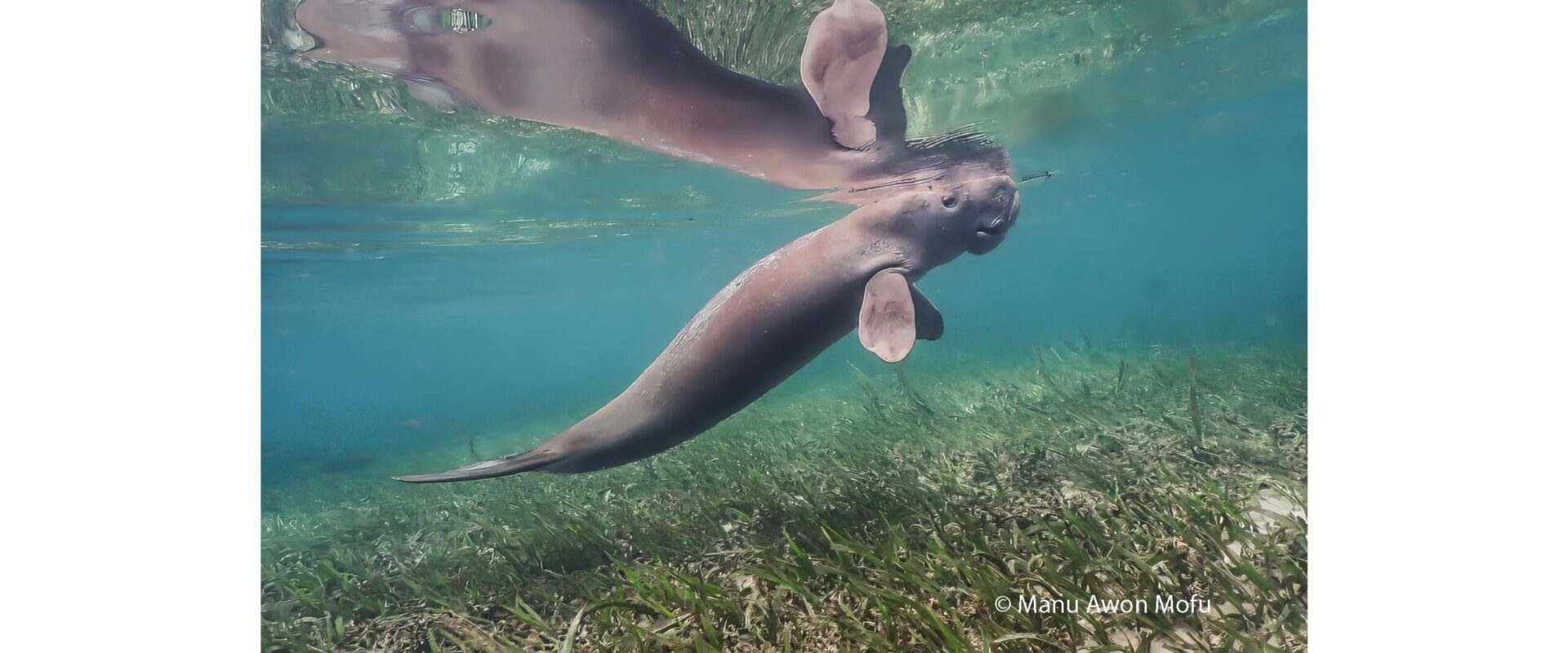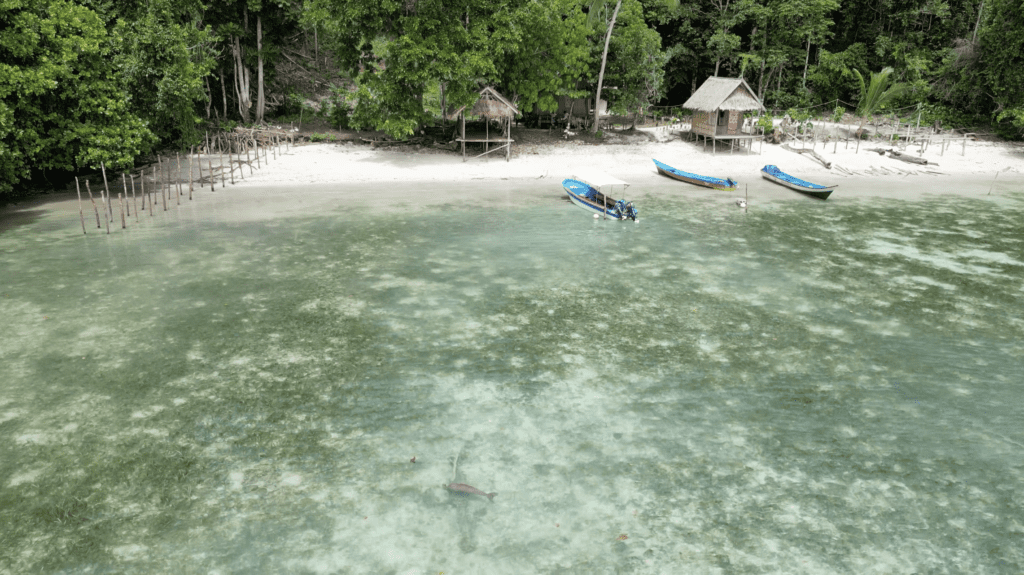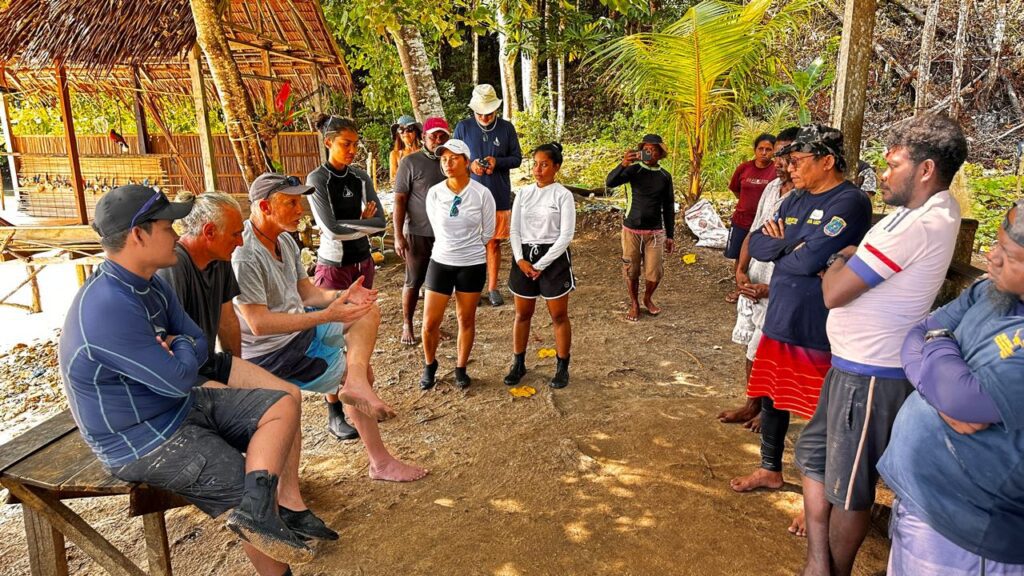Introducing “Manis”, the Orphan Dugong Calf by *Mark Erdmann & **Nesha Ichida
Last week, while hosting Dr. Paolo Martelli and nurse Chilli Chan from Ocean Park Hong Kong and Dr. Jaya Ratha, Director of Thrive Conservation (who were visiting the ReShark nurseries to conduct a veterinary assessment of our operations), we received word of a baby dugong that had been orphaned and was being raised by local community members near Friwen (with the help of several dive operators). Knowing how difficult this situation can be, we decided to take advantage of the presence of our veterinary team – and at the request of Pak Syafri Tuharea (head of the Raja Ampat MPA Management Board) – we brought Dr. Jaya, Dr. Paolo and nurse Chilli to Gam Island to check out the baby dugong.
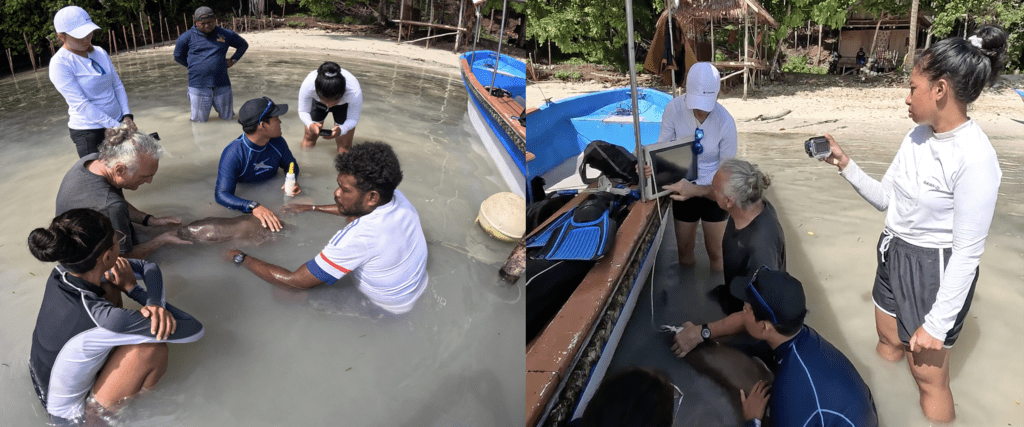
Dr. Paolo Martelli and Dr. Jaya Ratha conducting a health assessment on Manis with assistance from villager Alfius Tumurubun, Manu Awom Mofu (Raja Ampat MPA Management Authority), vet nurse Chilli Chan (Ocean Park HK), Nesha Ichida (Thrive Conservation) and Shannon Latumahina (Raja Ampat Research and Conservation Center). © Mark Erdmann
We arrived in front of the homestay on Gam where several villagers have been feeding the baby dugong, and almost immediately the little calf (a young female the locals are calling “Manis” (“Sweety”) ) swam over; seemingly seeking shade from the sun under our boat. Pak Syafri and the villagers were happy to have the vets conduct a check-up on Manis, who to our delight seemed quite healthy. After the vets had a close examination of Manis, including using a portable ultrasound machine to examine her lungs and digestive system, we sat down with the villagers to gain a better understanding of the situation, to explain the results of the examination and provide some recommendations.
As best we could piece together from the narratives of a number of community members and Pak Syafri and his MPA staff, it seems the calf was orphaned close to two months ago (the mother was found floating dead – cause of death unknown). When the villagers found the calf, she still had a wet umbilical cord, indicating she was separated from the mother almost immediately after birth. From this information, Dr. Paolo hypothesized that it is likely this calf never drank its mother’s milk, though we don’t know this for certain of course.
The villagers that found the calf brought her to a small sea pen constructed on the seagrass bed in front of the homestay they are operating, and apparently initially offered the animal rice (!) – which was summarily eaten by the fish on the reef flat. It was only a few weeks ago that Irenka, a tourist from the sailboat “Mothership Adrift”, was sailing past Friwen and noticed the calf. She alerted Heike from Tarzan Diving and Jack from Raja Ampat Eco Lodge to seek advice through their networks on how to best deal with Manis. Luckily, the information reached to Dr. Hidayatun Nisa (Ana) from Flying Vet – who had previously helped an orphaned dugong in Raja Ampat back in 2019 – and it was determined that the calf needed low-lactose milk in combination with greek yogurt as probiotic, fed to it through a bottle with a nipple fashioned from a rubber glove. For a week, Heike spent considerable time feeding the calf when she could, along with help from Pak Syafri’s team and milk and yogurt donations by LPSPL Sorong and BBKSDA Papua Barat. The calf was immediately released from the small sea pen and allowed to roam freely – and eventually settled into a routine of taking a full bottle of milk in the morning, then grazing on both the fine Halodule seagrass in front of the homestay as well as algae growing on a number of large submerged logs on the reef flat. It would often return for a half bottle of milk at midday and again in the afternoon, and in between it was several times observed to leave the safety of the seagrass bed and reportedly swim with the small herd of dugongs that frequent the area – though it would only remain with them for an hour or so before returning to the seagrass bed in front of the homestay.
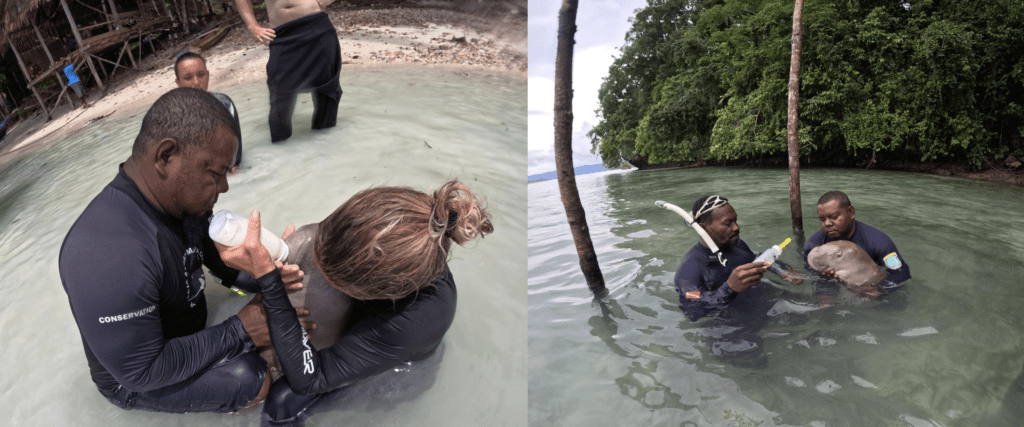
Heike, Manu and the MPA management team were on daily rotational schedule for almost two weeks, contributing their time to feed Manis while also showing the villagers on how to do it properly before completely handing over her care to the local community. Photo Credits: Local Dugong group
Drs Paolo and Jaya assessed that the dugong was quite healthy at the time we visited – the lungs seemed clear and healthy, breathing was normal, and both the stomach and the intestines were quite full. They commented to the villagers and Pak Syafri that they were actually surprised at how well the animal was doing, given the generally very poor prognosis for raising orphaned dugong calves. Dr. Paolo hypothesized that the fact the calf had to start eating seagrass and algae almost immediately was likely a positive, and he recommended that the villagers continue with the same routine that had been established – offering it milk 3 times a day, but never forcing the milk, and encouraging the calf to graze on seagrass and algae when it showed interest. They requested that the villagers should make note of how frequently the calf joined the herd of dugongs that often feed nearby, and how long it would spend with the herd at a given time. They noted that the calf should not be restrained in any way, but that it would be good if the villagers could build a small open “pondok” (basically, a simple roof of palm fronds supported by a number of vertical stakes into the seagrass) to provide the animal shelter from the sun during the heat of the day. Finally, they encouraged the Raja Ampat MPA Management Authority, LPSPL Sorong and BBKSDA Papua Barat to continue providing low lactose milk to the villagers, who are now solely responsible for feeding the calf, for as long as she shows interest.
After this we bid the villagers and Manis adieu. Paolo stressed to all of us that while he was quite amazed at how healthy the calf seemed, that overall, we should not be surprised if its condition worsens; he noted that even trained vets have struggled to keep orphaned dugongs alive for more than a few weeks. The fact that Manis has already made it 2 months is quite miraculous, and provides a glimmer of hope. A week after this visit, we received reports that Manis is still doing well and that she is enjoying her daily visit for milk under the new “pondok” the villagers have built for her. Dr. Jaya will do a follow-up assessment on Manis again in late August when he is scheduled to visit the ReShark nursery, and we’ll provide an update on her at that time.
Dugong facts:
Dugongs along with other sirenians (dugongs, manatees and the extinct Stellar’s sea cow), are termed “Sea Cows”, since their diet consists mainly of sea grasses. They are found in warm coastal waters from the western Pacific Ocean to the eastern coast of Africa. They are long-lived (50+ years), semi-nomadic, social animals. A mature dugong can reach 3 meters (10 feet) in length and on average weigh between 250-900 kilograms (550-1,980 pounds). Dugong’s do not reach sexual maturity until they are between 8 and 18 years of age, longer than most mammals. Despite their longevity, females give birth only a few times during their lives and invest considerable time in caring for their young. Normally females give birth to a single calf after a 13-15 month gestation period, which averages 1.2 meters (4 feet) long and weighs around 30 kilograms (65 pounds). The calf nurses for 14–18 months, although it begins to eat seagrasses soon after birth. A calf will only leave its mother once it has matured.
In Indonesia the dugong is a protected species under multiple jurisdictions including the Raja Ampat PERDA No. 9 Tahun 2012, UU No.5 Tahun 1990 on the Conservation of Natural Resources and Ecosystems, UU No. 31 Tahun 2004 on Fisheries, and KEPMEN KP No. 79 Tahun 2018 on National Action Plan on the Conservation of Marine Mammals.”
We would like to acknowledge on how amazing everyone from the local communities, government officials, dive resorts, tourists, NGOs and the global community have banded together to save one orphaned dugong. Baby Manis is a true example of conservation optimism. Additionally thanks go to Nathaniel Soon, Thrive’s Media and Communications Coordinator for his excellent video and editing work.
*Dr. Mark Erdmann, VP for Conservation International.
**Nesha Ichida, Thrive Conservation‘s program manager for their StAR and Rote projects





































